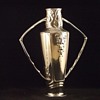Posted 6 years ago
 glasfreund
glasfreund
(36 items)
One of the largest commissioners of the Johann Lötz Witwe glassworks was the Viennese company E. Bakalowitz Söhne. Probably the most fruitful period of cooperation was around 1900. Several artists working for Bakalowitz, but also the retailer itself, designed glasses that were considered revolutionary for the time. This involved the shape of the glasses as well as the development of their own decors. The first objects, designed by artists in 1899, were produced with the monochrome Olympia decor, a light green tinted with uranium oxide. A little later, color combinations with Olympia were developed: Luna, Syrius, Vulcan and Violetta. Glasses with these decors were all made exclusively for Bakalowitz.
Three vases with consecutive numbering (85/3822 to 85/3824) are to be found in the paper patterns, whose decor and color designation is described as "heliotr. m. olympia" (heliotropic with olympia). Interestingly, with the exception of a lampshade, only these three vases are listed with this decor name. The color gradient from light, slightly opalescent violet to Olympia also applies to the Syrius decor, which was probably introduced somewhat later (first mention on production number 85/3833). However, it is also possible that there are slightly different color variations. A further characteristic of the three vases mentioned are the "Rüschen" pulled out of the glass, which look like small wings. The first model is in the Glasmuseum Passau, the third was auctioned at Quittenbaum ten years ago. Recently the second model 85/3823 appeared at an auction, so that it is now possible to present all three together with their paper patterns (picture 1).
Today it is hard to imagine how the glassmakers managed to pinch the wings out of the glass mass and at the same time to model the wall of the vessel smooth and uniformly strong (pictures 2 and 3). The glass mass is colored with uranium, the vase fluoresces accordingly strongly under black light. The light violet overlay, on the other hand, shows no fluorescence (Fig. 4).





































Great information and wonderful examples.
Volkmar, A great example of the Syrius decor. Congratulations on acquiring such a fine example. Thank you also for sharing some of the history of this decor. The "Heliotrope" description also explains why so many of these are represented as "Pansee verlaufend".
STUNNING !!!,!!!,!!!
Thank you for the nice comments and loves!
Love the top vase( 85/3822). The ruschen remind me of edible Oyster mushrooms protruding from the base of a tree. I have always wanted to see a example of this drawing.